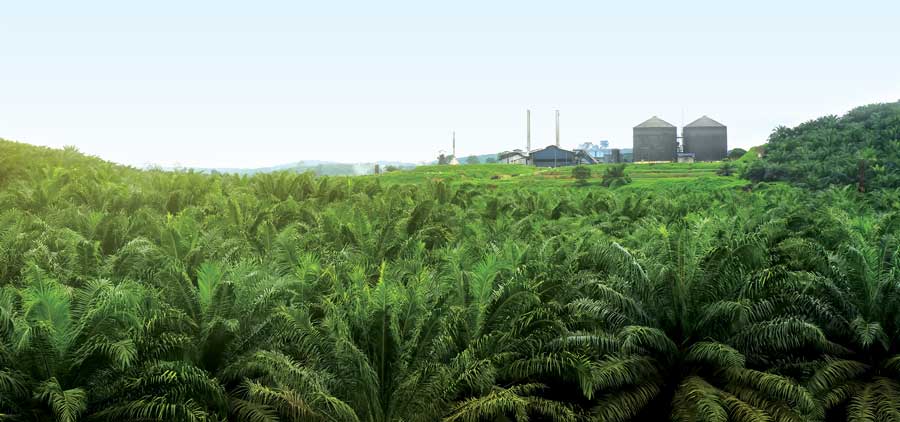



Small-scale electricity production
Malaysia’s plantations and CPO mills are managed by domestic public companies and also privately owned companies, each of which has potential to generate electricity from biogas or biofuel. At 45 tonnes FFB/hr, CPO mills may generate 2.5GW from biogas; at 60 tonnes FFB/hr, 4GW can be obtained.
Malaysia has 30GW installed generating capacity, as at 2017. As at 2018, less than half of its CPO mills generate electricity from biogas. A number of different processes range in productivity from 2.5 Mw to 4 Mw per CPO mill of 60 tonnes FFB/hr throughput.
Twenty percent of the CPO mills lie within 2km of the National Grid, offering these mills a choice – to sell power to the National Grid; use it at the CPO mill for additional electrical demand (personnel vehicle transport; FFB transport; CPO/PK transport to port; manufacture of biomass); to charge batteries to sell to the public; or to generate hydrogen and oxygen for remote power production.

Waste oil and dried biomass
CPO mills produce wastewater from six sources, four of which yield recoverable waste oil. Four of these – when passed over a desander tank, are reheated and allowed to decant for two hours in a heated shallow tank – yield 0.3%/FFB waste oil.
Twenty-two hours’ operation of a 60-tonne FFB/hr CPO mill may yield at least 4 tonnes of waste oil daily. If 352,000 tonnes FFB are processed annually, a CPO mill may recover 1,056 tonnes of waste oil, enough to cover a CPO mill’s annual wage bill. Up to half the waste oil is recovered from the empty bunch press drain; mills without this facility may require additional power generated by biogas/methane.
Biomass arises from three sources. Directors of CPO mills often prefer to recycle empty fruit bunches (EFB) in the plantation as untreated organic mulch. All CPO mills separate sterilised loose fruit from their bunch stalks at a bunch thresher. EFB stalks may amount to ±22 %/FFB of slightly oily EFB containing ±65% moisture which may be further treated by:
Several products can be put to commercial use:
Issues for the oil palm industry
Endemic insect and fungal parasites, including the rhinoceros beetle and Basal Stem Rot disease, threaten the future of Malaysian oil palm. An industry-wide organisation is recommended to focus on single issues, funded and managed by a consortium of major growers (as was the case previously for Elaedobius), with the commercial results of the consortium to remain the sole property of its ‘underwriters’ and the Ministry of Primary Industries.
Today’s situation calls for a Malaysian Growers’ Association to resolve a number of issues.
Basal Stem Rot
A number of indigenous species of palms suffer from vascular disease or fungal stem rot(s) of varying debility. No cultivated palms have yet suffered epidemic threats – defined as lethal infestations resistant to natural controls within the majority of established palm populations.
Basal Stem Rot disease caused by Ganoderma boninense does today represent a potential devastating threat to Southeast Asian palm populations, given that both Elaeis spp. are exotic species. E. oleifera, recently introduced to Southeast Asia and planted on a small scale only to date, has not shown advance warning of an epidemic. Removal of diseased palms and infected biomass represent the currently most effective control. A disaster lies in wait if Ganoderma is allowed to ramify throughout existing and replanted populations.
Rhinoceros beetle

The species Oryctes rhinoceros is long domesticated in Southeast Asia and in uncontrolled populations causes large losses of growth and yield, and even death of the palms. By coincidence, Oryctes larvae thrive under field conditions – i.e. with huge biomass left in the fields as a result of burning of biomass not being allowed – similar to those favouring multiplication of Ganoderma boninense. In Oryctes, only the egg, larval and pupal phases are static; its larval instars (aged between several months to 2 years) may represent a window of opportunity to introduce control measures.
Funding and research facilities need to be prioritised to study the major Oryctes and Ganoderma problems, and also removal or reduction of the old palm/plant biomass left on land cleared for planting oil palm.
Mechanisation
A fully documented review to reduce labour dependence on everyday field operations, particularly using modern machinery, is long overdue. Today’s successful oil palm industry has exacerbated Malaysia’s already very frail labour market, which is heavily dependent on foreign workers.
Planting material
A carefully edited presentation is needed to show data on a level playing field, comparing yields of individual hybrids, clones and clonal seed plantings grown in Malaysia for at least 10 years. The up-to-date data would be exclusively for reference by members of the Malaysian Growers’ Association.
Alternative tree crops
Tree crops might replace the oil palm as a source of edible oil. Coconuts remain the primary contender in the event of an unforeseen commercial disaster. Many years ago, extensive research was conducted to initiate tissue culture of elite coconut individuals, but subsequent multiplication (not in Malaysia) failed.
A new attempt to review the latest tissue culture technology is long overdue. If successfully cloned out to plantation level, a best individual coconut production of +-2.9 tonnes/ha (not in Malaysia) expeller coconut oil, 3.2 tonnes expeller meal and an unknown quantity of biomass/ha represent a future source.
Even this elite individual coconut, as yet uncloned, represents only 32% of a best individual oil palm potential (not in Malaysia) of 9.1 tonnes CPO/ha. Commercially available MAYTAG hybrid copra yields of 7 tonnes/ha, equivalent to 4.4 tonnes/ha coconut oil, are reported; however, the planting material availability and costs remain formidable.

Clearly, coconuts have a bright future amply justified by substantially lower labour demand and oil production costs. Malaysia’s current CPO/ha/annum average of 4.1 tonnes/ha is believed attributable to plantation labour shortage in the face of the limited best Malaysian commercial CPO yield/ha of 6 tonnes.
The labour requirement of coconuts under-farmed by cattle is reported outside Malaysia at 17 ha/employee/year compared with Malaysia’s current oil palm labour requirement, widely reported at <10.5 ha/employee/year. Fifty years after initial (failed) clonal research, urgent impartial research may now be due for reconsideration by a Malaysian Growers’ Association.
An invisible commodity?
Today’s world calls for an invisible commodity – kilowatts, preferably in the form of energy which can be supplied and transported on demand. Can today’s tree crops rise to this challenge?
CPO mills already contribute to the ‘kilowatt fever’. Plate boilers/steam turbines or methane-powered rotary alternators provide AC 3 ph 50cycle for vehicles; or DC power for vehicles; ‘24-hour’ back-up comes via batteries.
The real issue lies in the expense of transmitting electrical power from source to consumer. More than half of the potential output of Sarawak’s Bakun Dam is still awaiting reliable methods of DC transmission to potential consumers in Johor Bahru and Singapore. A convenient method is by onsite generation of hydrogen and oxygen (delivered to where required before conversion to electricity by rotary engine), but insurance companies are wary of accepting risk to the public.
Today’s world calls for ever-larger sources of energy. Hydrocarbon-powered rotary engines are replaced by electromotors. Oil palm plantations and CPO mills demand transport for personnel, FFB, CPO, PK and in due course, biomass. Storage batteries or accumulators become more affordable and practical by the day. In the foreseeable future, storage battery capacity will double, allowing 1,000km journeys between recharge.
Hydrocarbons are not readily homegrown, allowing national governments to impose sales taxes on both hydrocarbon producers and outlets. The future of homegrown kilowatts, less accessible to taxation, beckons.
Moray K Graham
Retired Planter
Pages : 1 2